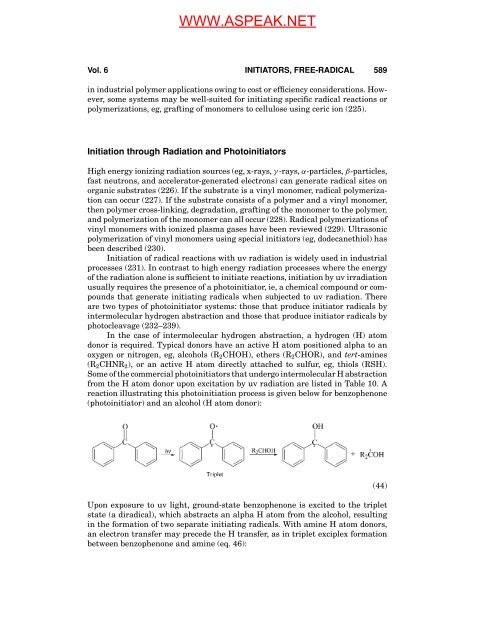"Initiators, Free-Radical". In: Encyclopedia of Polymer Science and ...
"Initiators, Free-Radical". In: Encyclopedia of Polymer Science and ...
"Initiators, Free-Radical". In: Encyclopedia of Polymer Science and ...
You also want an ePaper? Increase the reach of your titles
YUMPU automatically turns print PDFs into web optimized ePapers that Google loves.
WWW.ASPEAK.NET<br />
Vol. 6 INITIATORS, FREE-RADICAL 589<br />
in industrial polymer applications owing to cost or efficiency considerations. However,<br />
some systems may be well-suited for initiating specific radical reactions or<br />
polymerizations, eg, grafting <strong>of</strong> monomers to cellulose using ceric ion (225).<br />
<strong>In</strong>itiation through Radiation <strong>and</strong> Photoinitiators<br />
High energy ionizing radiation sources (eg, x-rays, γ -rays, α-particles, β-particles,<br />
fast neutrons, <strong>and</strong> accelerator-generated electrons) can generate radical sites on<br />
organic substrates (226). If the substrate is a vinyl monomer, radical polymerization<br />
can occur (227). If the substrate consists <strong>of</strong> a polymer <strong>and</strong> a vinyl monomer,<br />
then polymer cross-linking, degradation, grafting <strong>of</strong> the monomer to the polymer,<br />
<strong>and</strong> polymerization <strong>of</strong> the monomer can all occur (228). Radical polymerizations <strong>of</strong><br />
vinyl monomers with ionized plasma gases have been reviewed (229). Ultrasonic<br />
polymerization <strong>of</strong> vinyl monomers using special initiators (eg, dodecanethiol) has<br />
been described (230).<br />
<strong>In</strong>itiation <strong>of</strong> radical reactions with uv radiation is widely used in industrial<br />
processes (231). <strong>In</strong> contrast to high energy radiation processes where the energy<br />
<strong>of</strong> the radiation alone is sufficient to initiate reactions, initiation by uv irradiation<br />
usually requires the presence <strong>of</strong> a photoinitiator, ie, a chemical compound or compounds<br />
that generate initiating radicals when subjected to uv radiation. There<br />
are two types <strong>of</strong> photoinitiator systems: those that produce initiator radicals by<br />
intermolecular hydrogen abstraction <strong>and</strong> those that produce initiator radicals by<br />
photocleavage (232–239).<br />
<strong>In</strong> the case <strong>of</strong> intermolecular hydrogen abstraction, a hydrogen (H) atom<br />
donor is required. Typical donors have an active H atom positioned alpha to an<br />
oxygen or nitrogen, eg, alcohols (R2CHOH), ethers (R2CHOR), <strong>and</strong> tert-amines<br />
(R2CHNR2), or an active H atom directly attached to sulfur, eg, thiols (RSH).<br />
Some <strong>of</strong> the commercial photoinitiators that undergo intermolecular H abstraction<br />
from the H atom donor upon excitation by uv radiation are listed in Table 10. A<br />
reaction illustrating this photoinitiation process is given below for benzophenone<br />
(photoinitiator) <strong>and</strong> an alcohol (H atom donor):<br />
Upon exposure to uv light, ground-state benzophenone is excited to the triplet<br />
state (a diradical), which abstracts an alpha H atom from the alcohol, resulting<br />
in the formation <strong>of</strong> two separate initiating radicals. With amine H atom donors,<br />
an electron transfer may precede the H transfer, as in triplet exciplex formation<br />
between benzophenone <strong>and</strong> amine (eq. 46):<br />
(44)



